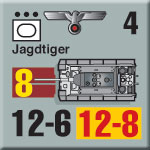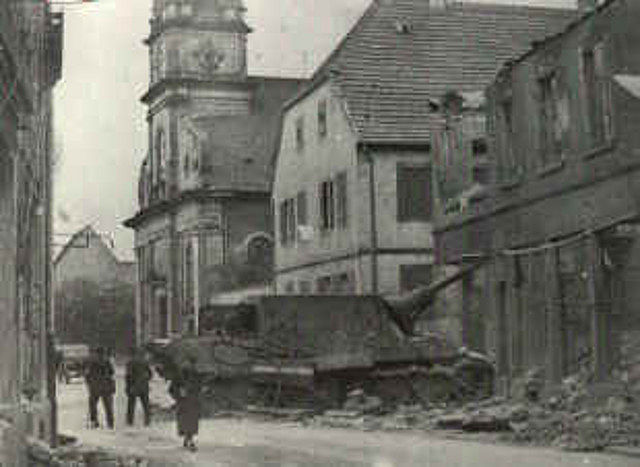Spearhead Division:
The Hunting Tiger
by Mike Bennighof, Ph.D.
December 2019
 Once the huge German PzKpfw VIb “Royal Tiger” with its long-barreled 88mm gun entered service, it was probably inevitable that a tank destroyer version with an even larger gun would appear. Once the huge German PzKpfw VIb “Royal Tiger” with its long-barreled 88mm gun entered service, it was probably inevitable that a tank destroyer version with an even larger gun would appear.
In early 1943 the German Army issued a request for designs for a new 128mm field gun, to counter the Soviet 122mm piece. Initially the requirement was only for a field gun in the same caliber as the very successful 12.8cm FlaK40 anti-aircraft gun, which was also being developed into the 128/42 dual-purpose naval gun, also a very successful weapon (at least in testing; it appeared too late to actually be mounted on a German warship). Following the typical pattern of all armies, the requirement then expanded to include an anti-tank role.
Krupp won the competition with a new design, beating out Rheinmetall-Borsig’s modified FlaK40. The new weapon performed well as a field gun. Its anti-tank performance was about the same as the 88mm Pak43 “barn door” anti-tank gun and close and medium ranges, but much better than the smaller gun at long ranges
If the 88mm Pak43 was difficult to swing into position in the field (thus its nickname), the 11-ton Pak44 – substantially larger and heavier than a 105mm field howitzer - was impossible to maneuver. A handful of barrels from the pre-productions series were put into service mounted on carriages scavenged from captured Russian 152mm howitzers or French 155mm GPF rifles, but the project was otherwise cancelled.
As a vehicular-mounted weapon, the Pak44’s problems no longer signified. The German Army’s Weapons Office had intended to mount the gun on a modified Royal Tiger chassis even before testing revealed the difficulties of the towed version. Design work began even before the gun had completed testing, and a wooden sample was presented in October 1943.
 The new tank destroyer, formally known as the Panzerjäger Tiger Ausf. B and informally known as the Jagdtiger (Hunting Tiger), carried a gun identical to the Pak44 except for its mount. The huge weapon had to be loaded with a separate charge and projectile and the Hunting Tiger crew included two loaders to handle this task. The ammunition included armor piercing and a very effective high explosive round and three different charges to enhance the artillery aspect of the piece. But despite the vehicle’s vast size the Hunting Tiger’s ammunition load only included 38 two-piece rounds total of both types combined. The new tank destroyer, formally known as the Panzerjäger Tiger Ausf. B and informally known as the Jagdtiger (Hunting Tiger), carried a gun identical to the Pak44 except for its mount. The huge weapon had to be loaded with a separate charge and projectile and the Hunting Tiger crew included two loaders to handle this task. The ammunition included armor piercing and a very effective high explosive round and three different charges to enhance the artillery aspect of the piece. But despite the vehicle’s vast size the Hunting Tiger’s ammunition load only included 38 two-piece rounds total of both types combined.
The vehicle itself was gigantic, weighing in at 72 tons (the Royal Tiger weighed 70 tons) on a lengthened Royal Tiger chassis. The Royal Tiger’s huge turret was replaced by a box structure, with frontal armor nearly 10 inches thick – about the same as a battle cruiser. It kept the engine and transmission of the Royal Tiger, which made it even slower and more difficult to handle than the original heavy tank.
In its heavily armored mount, the gun could only be traversed slightly from side to side, which meant that the crew had to move the entire vehicle in order to aim the weapon. The huge gun barrel had to be locked down on its support in order to move the Hunting Tiger any distance, which meant that someone had to climb out of the tank and unlock it during combat. The transmission broke down easily, often when trying to adjust the tank destroyer’s position to fire the gun, and the gun had to be re-calibrated often as the tank destroyer vibrated wildly when moving. When the gun did fire, it let out an enormous cloud of smoke compared to the 88mm gun, marking the Hunting Tiger’s position for enemy aircraft.
The German Army ordered 150 of the huge vehicles, receiving somewhere around 80 of them before the war’s end (it’s unclear how many Nibelungenwerk, the manufacturer, actually completed after the war had formally ended – Soviet occupation forces kept the lines open a short while to produce a few extra tanks for the victory parade in Moscow). They went to equip two heavy tank destroyer battalions, and had mixed success during the war. On at least two occasions they destroyed large numbers of American tanks and other vehicles, but more often they fell victim themselves to air attack or mechanical breakdown.

This Jagdtiger will hunt no more, destroyed by an American Sherman tank.
Success depended in large part on the experience of their crews; not only how much experience they had before joining the battalions but in what type of vehicle. Since the Hunting Tiger was based on the Royal Tiger tank, the German Army prioritized men who had served in units equipped with that tank or the earlier Tiger I. They appear to have uniformly despised the Hunting Tiger, feeling trapped in its armored box and disliking the need to aim the gun by moving the vehicle.
Otto Carius, who had commanded a Tiger I on the Eastern Front, hated his new vehicle and had little success in command of a company of them. But those who had operated other heavy tank destroyers and understood the limitations of the type liked it very much. Albert Ernst, a company commander in the same battalion as Carius, had commanded Nashorn heavy tank destroyers previously and managed a much better combat record. But Carius wrote a book about his experiences while Ernst did not, and so the negative impression drove the narrative about the Hunting Tiger.
Nibelungenwerk, the former Austrian factory of Steyr-Daimler-Pusch and the Third Reich’s largest tank factory, converted a line used to make PzKpfw IV medium tanks to build the huge Hunting Tiger (the Tiger was made at Henschel). The only German tank factory with a true production line, Nibelungenwerk apparently made the switch fairly easily, since the cranes and other equipment had been designed to accommodate the very large vehicles foreseen for the future German Army. Building a few hundred more medium tanks and getting them to the front earlier would probably have been a much better use of the materials and labor (mostly local Austrians, but also Czech forced laborers and Soviet prisoners of war) that went into the Hunting Tiger, but Nibelungenwerk’s ownership included Hermann Goering, who appears to have encouraged his boss to order the construction of such huge vehicles of questionable battlefield value (but of unquestionable profit potential) to help line Goering’s pockets. In the National Socialist order, as in any fascist state, personal profit came first.
We’ve included the Hunting Tiger in our Spearhead Division expansion book for Panzer Grenadier: Elsenborn Ridge. It’s a mighty beast, but a lumbering one, only barely faster than enemy infantry. And designer Mike Perryman has given you the opportunity to play with it in scenarios drawn from actual battles against the American 3rd Armored Division.
You can order Spearhead Division right here.
Sign up for our newsletter right here. Your info will never be sold or transferred; we'll just use it to update you on new games and new offers.
Mike Bennighof is president of Avalanche Press and holds a doctorate in history from Emory University. A Fulbright Scholar and award-winning journalist, he has published over 100 books, games and articles on historical subjects.
He lives in Birmingham, Alabama with his wife, three children and his dog, Leopold.
|
